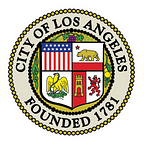A Data-Driven Exploration of Crime Trends in Los Angeles
By California State University Los Angeles, Math Professor Jie Zhong and students Gui He, Harshil Kotamreddy, Alvin Lew, Alex Sherzai
With the upcoming LA Mayoral Elections, one of the most frequently discussed issues is crime and public safety. For this project, we worked with the Mayor’s Data Team to use the City’s open data on crimes reported between 2010 to 2022 to evaluate long-term crime trends by neighborhood. Additionally, we explored the types of crimes that are most prevalent by neighborhood.
To conduct our analyses, the Data Team shared a merged version of the 2010 to 2019 Crime Dataset and the 2020 to Present Crime Dataset. The merged dataset included over 2.6 million records from 2010 to July 2022. The Data Team then geocoded all records and assigned each crime incident to their corresponding LA County Department of Public Health neighborhood designations (used in COVID-19 case rate tracking). They then shared the geospatially matched dataset with our team.
For our exploration, we focused exclusively on Part 1 crimes, which covered over 1.4 million records in the dataset. Part 1 crimes are considered to be more serious, violent crimes (such as homicide, arson, vehicle theft, etc.) and therefore, worthy of close examination. When referring to “crime rate,” we mean the number of Part 1 crimes per 10,000 residents.
We noticed that Part 1 crime rates had slightly increased between 2010 and 2021: from 289.5 to 303 crimes per 10,000 residents. On average, the number of Part 1 crimes has increased at a rate of roughly 1,000 per year, from 109,000 to 120,000.
Zooming into particular timeframes, there was a steady decrease in Part 1 crime from 2010 to 2014 and an increase from 2015 to 2018. After a sharp decrease in 2019–2020, Part 1 crime began to slowly increase through 2021. Since we only have half a year’s worth of data, we excluded 2022 from more in-depth analysis.
Next, we explored crime rates by community. We observed that a majority of communities experienced more than a 10% crime decrease in 2012, 2015, 2019, and 2020. On the other hand, a majority of communities experienced more than a 5% crime increase in 2016, 2018, and 2021. We suspect that the recent fluctuations in crime change have been impacted by the COVID-19 pandemic, which started affecting the city in March 2020 (explaining the decrease in 2020 and increase in 2021).
We also explored demographic trends in crimes reported. Overall, there are about 1.5x more male victims than female ones. Looking at victims by age, the largest increase occurs between ages 15–17. Victims of crimes peak between ages 23–25, after which point, there’s a steep and steady decline.
Next, we looked into victim descent to explore trends over time. Through a linear regression based analysis, we noticed that the White and Hispanic populations saw the greatest decrease in crime over the 12 year period, while Black and Asian populations saw the greatest increase in crime.
Through the use of linear regression, we were also able to identify the neighborhoods with the biggest increase and decrease in crime rate during the 12 year period. We found that the neighborhoods with the biggest increase in crime rate were Chinatown, Carthay, Wholesale District, and Downtown and the neighborhoods with the biggest decrease were Baldwin Hills, Toluca Woods, Century City, and Arleta.
Additionally, we collaborated with the LA City Data Team to create a map of crime trends over the 12 year period across all neighborhoods . Neighborhoods with an increase in crime are marked in orange, while neighborhoods with a decrease are marked in blue.
Through a finer three-year interval analysis, we noticed that 116 out of the 135 communities in our dataset saw a significant decrease in part one crime rate between the years 2018 and 2020. While we think this is due to the pandemic, we would need to do further analysis with COVID-19 data to be certain. Communities with the largest decrease in crime rate from 2018 through the pandemic are shown here:
Lastly, we performed an analysis on homicides, as it is one of the most serious of the part 1 crimes. Although overall crimes have not increased much over the past 12 years, we see a much more apparent spike in homicides. Homicides have been on a downtrend from 2016 to 2019, going from 287 homicides to 226 homicides. However, there was a significant spike in homicides in 2020 and 2021, when there were 335 and 380 homicides respectively.
Additionally, we found that:
- The male to female victim ratio is about 6 : 1, roughly four times higher than the ratio for all crime, 1.5 : 1
- Hispanic and Black populations were victims of more than 80% of homicides, compared to less than 30% of all crimes
- The distribution of the age of homicide victims is not too different compared to overall crimes; most victims are around the ages of 18–30
To explore crime trends in your LA neighborhood, check out this web app.
